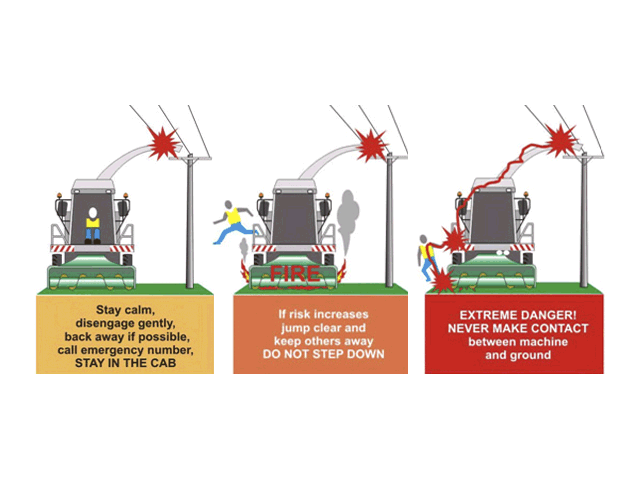Safety Around Overhead Power Lines
Farmers Need to Keep Eye Out for Overhead Power Lines, Power Poles
OMAHA (DTN) -- According to the National Ag Safety Database (NASD), every year 62 farm workers are killed from electricity-related accidents. In addition, 3.6% of deaths among youth under 20 years old are caused by electrocution (https://nasdonline.org/….
Fall is a busy time of year for farmers with long hours and fewer daylight hours to get the work done. Safety can sometimes take a back seat as those producers rush to get work done.
Alliant Energy recently issued a report titled "Harvest season safety tips for farmers" (see https://www.alliantenergy.com/…). Contact with power lines increases significantly at harvest due to more equipment being moved, newer equipment being larger and farmers working more hours in the dark when they can't see overhead lines.
The power company offers farmers various safety tips to avoid contact with electrical lines. These include:
-- Know the height of your equipment. Do not drive under any power lines if any part of the equipment is too tall to clear them.
-- Be aware of your turning radius. Make sure all equipment does not swing into poles or overhead lines when you turn. Pay special attention at the end of rows and at field entrances.
-- Stay safe during grain handling and storage. Alliant said to be alert when setting up and moving equipment. Boom, auger and grain bin use can place you near overhead lines.
P[L1] D[0x0] M[300x250] OOP[F] ADUNIT[] T[]
-- Stay alert, especially if it gets dark. Know where poles and lines are located at all times.
-- Know what to do if an overhead line is contacting equipment. Stay on the equipment and do not step to the ground while touching the equipment. Call 911 and wait until a qualified person can verify the line is not energized and tell you it's safe to exit the vehicle. If you must leave the equipment because of fire or some other danger, try to jump clear of the equipment so you don't touch the equipment or the ground at the same time. Land with both feet together. Shuffle away, keeping your feet together and on the ground.
-- Never assume a power line is safe to touch. If work requires you to be near a line, please call your power company and explain the situation. Most companies will discuss it with you or come to your site and make the line safe.
"Contact with power lines can interrupt electric service, which can halt work and slow other farming activities that require electricity such as grain drying until power is restored," the Alliant report said.
There are certain practices farmers can do to lessen their risk of electrocution, according to a South Dakota State University (SDSU) Extension report titled "Agricultural Safety Around Overhead Lines" (https://extension.sdstate.edu/…). Author John Keimig, SDSU Extension Youth Safety Field Specialist, wrote there are several recommendations producers can follow.
They include:
-- Be aware of the location of overhead power lines on your farm and choose a route for your equipment that avoids them.
-- Never touch a power line.
-- Avoid using ladders, portable augers or irrigation equipment around power lines.
-- Maintain 10 feet of clearance space between the power lines and your equipment. Contact your power company to determine the height of power lines on your farm.
-- Review safety measures with all individuals working on your farm, whether full-time or part-time.
-- Remember that even non-metallic objects such as tree limbs, ropes and straw can conduct electricity.
"Don't have an unfortunate harvest season and become a farm accident statistic," Keimig wrote. "Assessing your electrocution hazards around your farm and fields and developing a plan may save a life this year."
Russ Quinn can be reached at Russ.Quinn@dtn.com
Follow him on Twitter @RussQuinnDTN
(c) Copyright 2022 DTN, LLC. All rights reserved.



